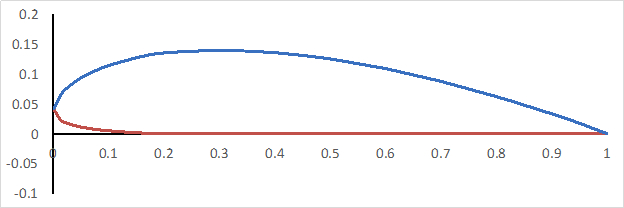Clark Y-14 Wing Performance: Deployment of High-lift Devices (Flaps and Slats)
Source: David Guo, College of Engineering, Technology, and Aeronautics (CETA), Southern New Hampshire University (SNHU), Manchester, New Hampshire
A wing is the major lift-generating apparatus in an airplane. Wing performance can be further enhanced by deploying high-lift devices, such as flaps (at the trailing edge) and slats (at the leading edge) during takeoff or landing.
In this experiment, a wind tunnel is utilized to generate certain airspeeds, and a Clark Y-14 wing with a flap and slat is used to collect and calculate data, such as the lift, drag and pitching moment coefficient. A Clark Y-14 airfoil is shown in Figure 1 and has a thickness of 14% and is flat on the lower surface from 30% of the chord to the back. Here, wind tunnel testing is used to demonstrate how the aerodynamic performance of a Clark Y-14 wing is affected by high-lift devices, such as flaps and slats.

Figure 1. Clark Y-14 airfoil profile.
- For this procedure, use an aerodynamics wind tunnel with a test section of 1 ft x 1 ft and a maximum operating airspeed of 140 mph. The wind tunnel must be equipped with a data acquisition system (able to measure angle of attack, normal force, axial force and pitching moment) and a sting balance.
- Open the test section, and install the wing on the sting balance. Start with clean wing configuration.
- Place a handheld inclinometer on the sting balance, and adjust the pitch angle adjustment knob to set the sting balance
The results of the clean wing configuration are shown in Table 1. Figures 6 - 8 show all three coefficients vs angle of attack, α, for all four configurations. From Figure 6, both the flap and slat enhanced the lift coefficient, but in different ways. Comparing the clean wing and the slat lift curve, the two curves are almost overlapping at low angles of attack. The clean wing lift curve peaks to about 0.9 at 12°, but the slat curve continues to rise to 1. 4 at 18°. This in
Lift generation can be enhanced by the deployment of high-lift devices, such as flaps and slats. Most airplanes are equipped with flaps, and all commercial transport airplanes have both flaps and slats. It is critical to characterize the performance of a wing with flaps and slats during aircraft development.
In this demonstration, a Clark Y-14 wing with a flap and a slat was evaluated in a wind tunnel. The forces and moment measurements were collected to determine the lift, drag and pitching m
- John D. Anderson (2017), Fundamentals of Aerodynamics, 6th Edition, ISBN: 978-1-259-12991-9, McGraw-Hill
Passer à...
Vidéos de cette collection:

Now Playing
Clark Y-14 Wing Performance: Deployment of High-lift Devices (Flaps and Slats)
Aeronautical Engineering
13.2K Vues

Performances aérodynamiques d'un modèle réduit d'avion : Le DC-6B
Aeronautical Engineering
8.1K Vues

Caractérisation de l'hélice : Variations du pas, du diamètre et du nombre de lame sur la performance
Aeronautical Engineering
26.0K Vues

Comportement de l'aile : Distribution de la pression sur une aile de Clark Y-14
Aeronautical Engineering
20.8K Vues

Méthode des sphères de turbulence : Évaluation de la qualité de l'écoulement en soufflerie
Aeronautical Engineering
8.6K Vues

Flux cylindrique croisé : Mesurer la distribution de la pression et estimer les coefficients de traînée
Aeronautical Engineering
16.0K Vues

Variations du nombre de Mach et de la pression le long d'une tuyère convergente et d'une tuyère de Laval
Aeronautical Engineering
37.7K Vues

Imagerie Schlieren: Une technique pour visualiser les caractéristiques des écoulements supersoniques
Aeronautical Engineering
11.2K Vues

Visualisation de l'écoulement dans un tunnel hydrodynamique : Observation d'un tourbillon sur une aile Delta
Aeronautical Engineering
7.8K Vues

Visualisation de l'écoulement de colorants en surface : Une méthode qualitative pour visualiser les lignes de courant dans un écoulement supersonique
Aeronautical Engineering
4.8K Vues

Tube de Pitot : Un dispositif pour mesurer la vitesse du flux d'air
Aeronautical Engineering
48.4K Vues

Anémomètre à température constante : Un outil pour étudier les écoulements dans la couche limite turbulente
Aeronautical Engineering
7.1K Vues

Transducteur de pression : Calibrage à l'aide d'un tube de Pitot
Aeronautical Engineering
8.4K Vues

Contrôle de vol en temps réel : Étalonnage de capteurs embarqués et acquisition de données
Aeronautical Engineering
10.0K Vues

Aérodynamique des multicoptères : Caractérisation de la poussée sur un hexacoptère
Aeronautical Engineering
9.0K Vues